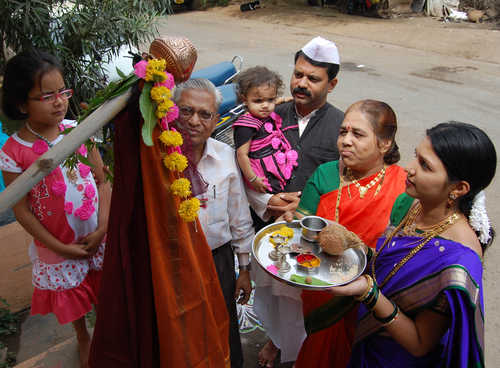Gudhi Padwa - The Harvest festival of Maharashtra

Gudhi Padwa signifies the beginning of a prosperous new year and Hindus consider it to be one of the most auspicious days. It falls on the first day of the Lunar calendar, marking the new year. It is celebrated with great pomp and show all over the state. Households are decorated with garlands and rangolis, and a gudhi is put up outside the home to welcome prosperity and good health in to the family. Gudhi is a symbol of victory, characterized by a bamboo stick with a silk cloth. It is garlanded with flowers and has sweets offered to it.
People bring in the new year by worshipping the gudhi and distributing prasad among the people in the community. Sweet dishes like shrikhand or basundi are prepared and relished by adults and children alike. There are many processions in several parts of the state that celebrate the culture and traditions of Maharashtra. People throng in thousands to see the festivities and partake in the celebrations. This day is one of the saade-teen muhurtas and any new venture started on this day is believed to bring success and prosperity. Therefore, this day is considered very auspicious for purchasing or moving into a new home, purchasing a car, starting a new business etc.
Historical Legends and Beliefs
One of the sacred texts of the Hindus, the Brahma Purana states that Lord Brahma recreated the world after a raging deluge in which all time had stopped and all the people of the world, destroyed. On Gudi Padva, time restarted and from this day on, the era of truth and justice (known as Satyug) began. Therefore, Lord Brahma is worshipped on this day.
Another popular legend about the origin of this festival revolves around the return of Lord Rama to Ayodhya along with his wife Sita and his brother Laxman from exile. The ‘Brahmadhvaj’ or ‘the flag of Brahma’ (other names for the Gudi) is hoisted in memory of the coronation of Lord Rama. The Gudi is hoisted at the entrance of the household in commemoration of the Gudi that was hoisted in Ayodhya as a victory flag. It is also believed that Lord Rama was victorious over King Bali on this day, marking this occasion.
For the people of Mahrashtra, there is an added significance to this festival. It is believed that Chhattrapati Shivaji Maharaj, celebrated leader of the Maratha clan, led the troops to victory and attained freedom for the kingdom from the dominion of the Mughals in that area. The Gudi then is a symbol of victory and prosperity.
It is believed that hoisting the Gudi outside ones home wards off any evil influences, making way for good luck and prosperity. Many businessmen inaugurate their ventures on this day as it is considered an auspicious day.
Preparation of the Gudi
The Gudi is made by purchasing a bright green or yellow silken cloth with a zari brocade on it and tying it on to a long bamboo stick. On top of the cloth then, neem leaves, gathi (a Maharashtrian sweet preparation), a garland of red or yellow flowers and a twig with mango leaves are also tied. This stick with the various ornaments is topped off with an inverted silver or copper pot. The Gudi is placed either at the gate or outside the window.


Informative
ReplyDelete